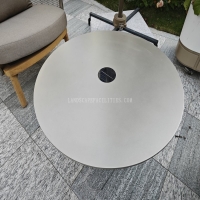Welcome to the website for landscape facilities products and knowledge.
What are the options for adding heating or cooling elements to the table for seasonal comfort?
As seasons change, so do our comfort needs. The integration of heating and cooling elements into tables has emerged as an innovative solution for maintaining optimal comfort throughout the year. Modern furniture technology offers several approaches to achieve this climate-controlled functionality.
For heating solutions, manufacturers have developed tables with built-in radiant heating systems. These typically use low-voltage carbon fiber heating elements embedded beneath the table surface, providing consistent warmth without visible components. The temperature can be precisely controlled through digital interfaces, allowing users to set their preferred warmth level. Some advanced models even feature zone-specific heating, enabling different temperature settings across various table sections.
Cooling integration presents more technical challenges but has seen significant advancements. Active cooling systems utilize thermoelectric (Peltier) technology, which can lower surface temperatures by 10-15 degrees Fahrenheit. These systems are particularly valuable in warmer climates or for specific applications like gaming stations where equipment generates additional heat. Passive cooling solutions incorporate phase-change materials within the table structure that absorb excess heat, gradually releasing it as the environment cools.
DIY enthusiasts have developed creative approaches using readily available components. Heating pads designed for reptile terrariums can be adapted for table use when properly insulated and controlled with thermostats. For cooling, small computer fans can be installed beneath the table surface to circulate air, though this provides ventilation rather than true cooling.
Smart technology integration represents the cutting edge of climate-controlled furniture. Wi-Fi enabled tables can connect to home automation systems, adjusting temperature based on room conditions or user preferences. Some models incorporate sensors that detect user presence and automatically activate the climate control features.
Safety remains paramount in all these systems. Modern heated tables include automatic shut-off features and overheat protection. Cooling systems are designed to prevent condensation buildup, which could damage electronics or cause slipping hazards.
The choice between these options depends on several factors: intended use, budget constraints, and installation requirements. Built-in systems offer seamless integration but come at a higher cost, while modular solutions provide flexibility for existing furniture. As technology advances, we're seeing more compact and efficient systems that make climate-controlled tables increasingly accessible for both residential and commercial applications.
Ultimately, adding thermal comfort elements to tables represents the convergence of furniture design and environmental control technology. Whether through professional installation or creative DIY solutions, these innovations allow users to maintain perfect comfort regardless of external weather conditions, transforming ordinary tables into responsive, personalized comfort zones.
Related search:

Recommendation
Outdoor stainless steel table with solar-powered ambient lighting feature - excellent design.